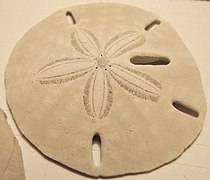
An echinoderm is any member of the phylum Echinodermata. The adults are recognisable by their radial symmetry, or pentamerous symmetry, and include starfish, brittle stars, sea urchins, sand dollars, and sea cucumbers, as well as the sea lilies or "stone lilies". Adult echinoderms are found on the sea bed at every ocean depth, from the intertidal zone to the abyssal zone. The phylum contains about 7,000 living species, making it the second-largest grouping of deuterostomes, after the chordates. Echinoderms are the largest entirely marine phylum. The first definitive echinoderms appeared near the start of the Cambrian.

Crinoids are marine invertebrates that make up the class Crinoidea. Crinoids that are attached to the sea bottom by a stalk in their juvenile form are commonly called sea lilies, while the unstalked forms, called feather stars or comatulids, are members of the largest crinoid order, Comatulida. Crinoids are echinoderms in the phylum Echinodermata, which also includes the starfish, brittle stars, sea urchins and sea cucumbers. They live in both shallow water and in depths as great as 9,000 meters (30,000 ft).

Sea urchins are spiny, globular echinoderms in the class Echinoidea. About 950 species of sea urchin are distributed on the seabeds of every ocean and inhabit every depth zone from the intertidal seashore down to 5,000 meters. The spherical, hard shells (tests) of sea urchins are round and covered in spines. Most urchin spines range in length from 3 to 10 cm, with outliers such as the black sea urchin possessing spines as long as 30 cm (12 in). Sea urchins move slowly, crawling with tube feet, and also propel themselves with their spines. Although algae are the primary diet, sea urchins also eat slow-moving (sessile) animals. Predators that eat sea urchins include a wide variety of fish, starfish, crabs, marine mammals, and humans.

Sand dollars are species of flat, burrowing sea urchins belonging to the order Clypeasteroida. Some species within the order, not quite as flat, are known as sea biscuits. Sand dollars can also be called "sand cakes" or "cake urchins".

Sea cucumbers are echinoderms from the class Holothuroidea. They are marine animals with a leathery skin and an elongated body containing a single, branched gonad. They are found on the sea floor worldwide. The number of known holothurian species worldwide is about 1,786, with the greatest number being in the Asia-Pacific region. Many of these are gathered for human consumption and some species are cultivated in aquaculture systems. The harvested product is variously referred to as trepang, namako, bêche-de-mer, or balate. Sea cucumbers serve a useful role in the marine ecosystem as they help recycle nutrients, breaking down detritus and other organic matter, after which bacteria can continue the decomposition process.

Meoma ventricosa, known by the common names cake urchin and red heart urchin, is a large species of sea urchin which lives in shallow waters in the Caribbean. It may reach a diameter of twenty centimeters and is covered in reddish-brown spines. It has both pentagonal radial symmetry and bilateral symmetry, giving it a sand-dollar appearance; however, two of its five sections are merged more closely than the others.
Cassiduloida is an order of sea urchins. The group was extremely diverse with many families and species during the Mesozoic, but today, only seven extant species remain.

The heart urchins or Spatangoida are an order of sea urchins.
The Phymosomatoida are an order of sea urchins, found in Europe, North America, North Africa and the Middle East.

Dendraster excentricus, also known as the eccentric sand dollar, sea-cake, biscuit-urchin, western sand dollar, or Pacific sand dollar, is a species of sand dollar in the family Dendrasteridae. It is a flattened, burrowing sea urchin found in the north-eastern Pacific Ocean from Alaska to Baja California.

Holasteroida is an order of irregular sea urchins.

Clypeaster, common name "cake urchins" or "sea biscuits", is a genus of echinoderms belonging to the family Clypeasteridae.

Heliophora orbicularis, also known as the West African Sand Dollar, is a small sand dollar in to the family Rotulidae, and the only species in the genus Heliophora. It, and other members of Rotulidae have been found in West African marine strata from the Late Miocene onward. Like the related Rotula, it is still extant.

The Neognathostomata are a superorder of sea urchins.

Clypeaster reticulatus, the reticulated sea biscuit, is a species of sea urchin in the family Clypeasteridae. This species was first scientifically described in 1758 by Carl Linnaeus. It lives on the sandy seabed of shallow seas, semi-immersed in the sediment.

Clypeaster rosaceus, the fat sea biscuit, is a species of sea urchin in the family Clypeasteridae. It occurs in shallow water in the western Atlantic Ocean and was first scientifically described in 1758 by Carl Linnaeus.

Clypeaster humilis is a species of sea urchin in the family Clypeasteridae. This species was first scientifically described in 1778 by the German biologist Nathanael Gottfried Leske. It occurs in the tropical Indo-Pacific region.

Clypeaster japonicus, the Japanese sea biscuit, is a species of sea urchin in the family Clypeasteridae. This species was first scientifically described in 1885 by the German zoologist Ludwig Heinrich Philipp Döderlein.

Leodia sexiesperforata, commonly known as the six-holed keyhole urchin, is a species of sand dollar, in the echinoderm order Clypeasteroida. It is native to tropical and sub-tropical parts of the western Atlantic Ocean where it buries itself in soft sediment in shallow seas.

Echinocyamus pusillus, commonly known as the pea urchin or green urchin, is a species of sand dollar, a sea urchin in the family Fibulariidae, native to the northeastern Atlantic Ocean and the Mediterranean Sea. It buries itself in gravel or coarse sand at depths down to about 1,250 m (4,000 ft).





























